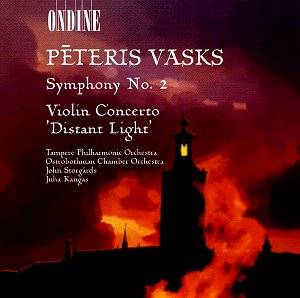Vasks'
catalogue includes many smaller scale works, often choral. Perestroika
and the restored independence of Latvia led to the composition
of a series of much larger-scale works. In addition to the two
represented here there are the First Symphony Balsis or
Stimmen or Voices (for strings) (1990-91) and the
Cello Concerto (1993-94).
The
First Symphony Balsis ('Voices') was composed during the
upheavals of the late 1980s with the ejection of the Soviets and
street fighting and casualties in Riga and Vilnius. That conflict
is mirrored in the violence in the first movement of the Second
Symphony. At 10.03 however the music possesses a meditative
calm like that broadcast by the prayerful string writing in Arvo
Pärt's Cantus. This returns in the last five minutes
of the work - the calm of benediction, the peace of homecoming
after grief. Before that there is strong neo-Sibelian writing
with some most un-Sibelian writing for percussion (23.00). This
rises to a long lyrical sunburst of a climax combining the ecstatic
qualities of the finales of Ravel's Ma Mère l'Oye and
de Falla's El Amor Brujo. Then just as we are sure this
will all end in a glowing sunset comes a sudden violent disenchantment
in which Shostakovichian vitriol blasts the scene. The composer
tells us much about dissolution and the collapse of things into
chaos but then finds a sometimes gaudy triumph that rises above
destruction. This work was premiered by the Bournemouth Symphony
Orchestra conducted by Yakov Kreizberg during the 1999 Proms.
It was a BBC commission.
The
Violin Concerto is an epic meditation which like the Second
Symphony is in a single movement. Tālā Gaisma (Distant
Light) is a concerto for solo violin and large string orchestra.
It begins with the violin warbling high and quiet in the stratosphere.
Sporting Hovhaness-like slides and a benign, invocational atmosphere
this work was composed after a request from Gidon Kremer. The
composer discovered that Kremer had attended the same school.
Vasks describes the work as 'nostalgia with a touch of tragedy.
Childhood memories, but also the glittering stars millions of
light years away." The mood is comparable with the wondering almost
cerebral calm of Urmis Sisasks ‘star’ pieces. Other echoes include
the Introit by Gerald Finzi, Arvo Pärt's Cantus,
Gorecki's Symphony of Sorrowful Songs and Kancheli's Simi.
There are several episodes of spirited virtuosity as in the Miaskovsky-inflected
section at 14.18, the violent 'hailstorm' at 25.50 and the grand
stretto at 16.43 the latter of which reminded me of Bliss's Music
for Strings. At the end there is the shred of a reminiscence
of a Prokofiev-like dance and a retreat into the stratospheric
firmament out of which the work emerged. Magical! The work was
premiered by Kremer at the Salzburg Festival in 1997; the first
time in the festival's history that a Latvian work had been performed
there.
The
notes by Johan Christiaan Snel are judged to perfection. Musical
technicalities are completely absent. Both works are luminously
recorded and although the sessions were in two locations there
are no jarring differences.
These
are two rewarding lyrical works written during the last decade,
generously coupled, passionately performed and luminously recorded.
Rob
Barnett
